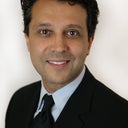Thank you for your question mayfly. I understand your concern. Botox is a purified protein used to address wrinkles associated with facial expression. When injected into the skin Botox will relax the muscles and smoothen out the overlying wrinkles. The most common areas of treatment are in the upper face. These include the horizontal lines seen on the upper forehead when one raises the brows, the vertical lines seen between the brows when one frowns (frown lines), and the crow's feet seen around the eyes when one smiles.It is difficult to make an assessment in the absence of consistent photographs before and after in the same lighting and angles for comparison. However, I hope the information provided here is useful.The appearance of frown lines is variable from person to person. Usually they are in a vertical orientation but sometimes they can be oblique and sometimes a horizontal line is seen across the upper portion of the nasal bridge. The most common variation is to have two parallel lines, hence the common term "11's" to describe them. But some people have one, three, or more lines. Some people also will see a bulge in the area when contracting the muscle. This bulge is smoothened out after a Botox treatment.When patients present with concerns about specific wrinkles in the upper face such as the frown lines, I always assess and usually treat the other wrinkles in the upper face including the horizontal forehead wrinkles and crow’s feet. The reason is to maintain a harmonious and natural balance to the appearance of the upper face. The muscles in the glabella which are responsible for the formation of the frown lines serve to pull down on the inner brows when a person frowns. Similarly, the muscles around the eyes which are responsible for the formation of the crow’s feet seen when smiling (orbicularis oculi) are also responsible for pulling down on the brows, but in this case the outer brows. On the other hand, the muscle in the upper forehead which is responsible for the formation of the horizontal forehead wrinkles when a person raises the brows (frontalis) serves to pull the brows upward. If one of these muscles is relaxed with Botox and the others are not, the other muscles will still be active. This will lead to an unbalanced and unnatural appearance of the upper face where the brow can be elevated, depressed, or uneven in shape or position. Therefore, I recommend that my patients take a global approach to the upper face when receiving Botox treatments and treat all three of these areas. Sometimes bunny lines on the bridge of the nose are also treated.When Botox is used in the upper forehead, if the dose is too high or the placement is too low it can result in the feeling of heaviness in the eyebrow or even lower the position of the brow. In order to reduce the risk of this possibility, I use a conservative dose in the area and place the product high on the forehead, sometimes near the hair line. Additionally, I recommend that my patients simultaneously receive a small amount Botox between the brows and at the corners of the brows. This will relax the muscles that pull down on the brows to counteract this effect and provide a harmonious balance to the position of the brow. The results are assessed two weeks after the treatment. If there is any asymmetry a small amount of Botox can be placed in the upper face for correction.Sometimes after a Botox treatment a peaked appearance of the eyebrow is seen. This is sometimes called the Spock or Mephisto look, which makes a person appear surprised or sinister. It is also called the Jack Nicholson look, after the appearance of his eyebrows. This can occur if the muscles that pull the eyebrow down are relaxed with Botox. It can also occur if the upper forehead only is treated. In this case the inner portions of the muscles are relaxed preferentially over the outer portions of the muscle. This allows the outer portions of the muscle to pull up on the tail of the eyebrow. While some people desire this appearance, others do not. This effect can be corrected by placing a small amount (1-2 units) of Botox in the upper forehead approximately midway between the eyebrow and the hair line at the peak of the brow. This relaxes the muscle that pulls up on the tail of the eyebrow, thereby restoring a natural appearance.If I had a patient with the concern described here I would like to first assess the before and after photographs. Without this information I would say the course of action described here is appropriate.With any injection, there are risks such as pain, bleeding, bruising, redness, swelling, tenderness, and infection. We take special precautions to minimize these risks such as using a painless technique. We also treat bruises with a laser as early as the next day. Bruises usually resolve within two weeks if untreated. After a laser treatment bruises usually resolve in 1-3 days, but may still take two weeks for full resolution. In addition to these risks, with Botox there is also a risk that the product spreads or diffuses to nearby structures. Spread to nearby muscles can lead to side effects such as the temporary appearance of droopy eyelids or a temporary asymmetric smile.







